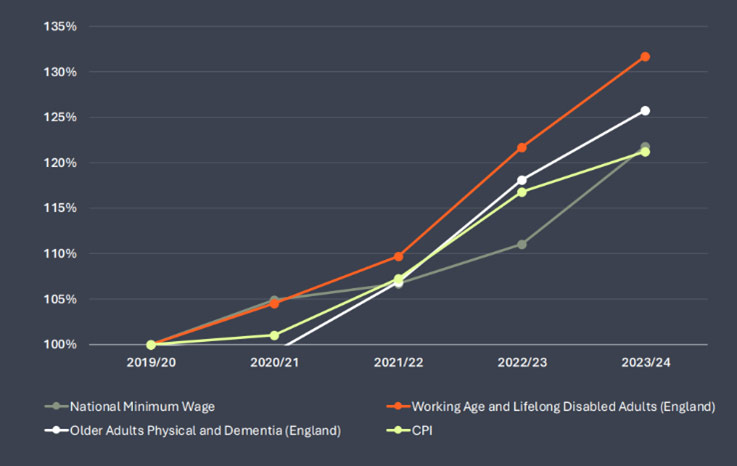Tackling the challenges in specialist social care sectors: Learning & Disabilities and Children & Young People
The UK’s specialist social care sectors – particularly in adult Learning & Disabilities (L&D) and residential care for Children & Young People (CYP) – are facing acute pressures. Financial constraints, rising demand, workforce issues, regulatory challenges and questions around long-term sustainability all shape the landscape. Below, we examine the issues in more detail and outline potential solutions.
Learning & Disabilities – the challenges
In L&D it’s the same story as mainstream social care – there’s simply not enough people or money to meet the rising demand for services.
Rising costs, static numbersWhile the total number of adults in L&D life-long care has remained largely static, the intensity and complexity of needs is expanding. Net commissioned spend for L&D adults comprised 63% of all adult social care expenditure in 2023/24, even though L&D adults are only 40% of all adult social care users. Spending on L&D care is rising at double the rate of physical support, far outpacing inflation and wage increases. Sustained financial pressureMost L&D clients require life-long support and are less likely to exit care, creating a cumulative financial burden. Care providers anticipate even greater financial stress ahead, given the escalating cost base and longstanding underfunding. The sector is described as ‘teetering on the brink of collapse’ without urgent, multi-year investment and a credible government settlement. | |  |
Workforce shortages and inequality
Chronic staffing shortages persist, fuelled by lower pay than NHS equivalents and difficult working conditions. People with learning disabilities also continue to face poorer health outcomes, lower life expectancy and gaps in skilled, personalised support.
Learning and disabilities – potential solutions
Central and local government, the NHS and local advocacy groups are working to reverse the issues of underfunding, erratic care provision and the challenges driving the talent shortage in social care.
Multi-year funding and pay parity: In an effort to head off the financial crisis in L&D, advocacy groups are urging government commitment to multi-year settlements, increased pay and workforce development – bringing care staff pay and conditions closer to NHS levels.
Investment in home adaptations: The government has announced £86 million in additional funding (2025) for home adaptations, aiming to help thousands more L&D adults live independently and safely at home, easing pressure on more costly residential care.
National reform and best practice: New guidance from the Social Care Institute for Excellence (SCIE) targets inequalities by improving workforce skills, knowledge and legislative awareness surrounding L&D care. Local health and care partnerships are
experimenting with person-centred, community-based services and high-quality specialist units – such as the Kingfisher Unit in the South-West – focusing on therapeutic, personalised support that’s closer to home.
Cross-party commission: The newly announced independent commission on adult social care is aiming to break the cycle of fragmented reform and deliver sustainable, wholesale change for working-aged adults with disabilities.
Children & Young People – the challenges
Even though demand growth has been moderate, rapidly escalating costs, too few residential places available where they’re needed and a lack of foster carers have created a perfect storm of issues in CYP residential care.
Soaring costs, modest growth in demand
Local authority spending on CYP residential care surged between 2020 and 2024, although the number of children in residential care only grew by 7% in 2023/24. Costs are being driven higher by a shortage of suitable placements and a rising share of provision by private, for-profit operators – sometimes charging more than £10,000/week per child.
72%
Rise in local council expenditure on CYP residential care, 2020- 2024.
Source: Local Gov Chronicle 2024
Market mismatch
The Competition and Markets Authority (CMA) found a mismatch between the distribution of registered children’s homes and local demand, leaving councils with little bargaining power. Some providers have posted high profits, while 46% of councils overspent on children’s social care by 20% or more in 2024-25.
Placement quality and availability
There is an acute shortage of foster carers and regulated homes, particularly for the most complex cases, leading to ‘out-of-area’ placements that disrupt young people’s education and family ties. Unregulated and low-quality placements have also attracted sharp criticism and invited regulatory crackdowns.
Children & Young People – potential solutions
Early intervention and prevention: The government’s Stable Homes, Built on Love strategy has pivoted policy towards early intervention – delivering tailored support to families before escalation to crisis, with £200 million in initial funding and a multi-phase reform plan.
Investing in placement supply and quality: Recent spending reviews have boosted funding; £1.1 billion in new commitments, plus extra capital for children’s home expansion and fostering capacity. The government is aiming to add hundreds of new secure and open home placements and build specialist community-based alternatives for children with complex needs.
Regional co-operations and market regulation: Regional commissioning co-operatives have been re-designed to strengthen councils’ purchasing power, boost local placement supply and curb excessive provider profits. Additionally, new legislation aims to enable greater scrutiny and potentially put caps on provider profits if voluntary measures fail.
Fostering system reform: Additional investment and pilot programmes such as ‘Mockingbird’ are targeting foster carer recruitment and retention, although sector leaders warn that broader, sustained funding will be necessary to match the scale of need and to put a stop to the continued reliance on expensive crisis provision.
Light at the end of the tunnel
The challenges faced by specialist social care sectors are severe, but as discussed above, solutions do exist. Long-lasting progress will require robust, multi-year government funding, a commitment to workforce reform, investment in home/community adaptations and structural changes to market regulation and commissioning.
Meanwhile, early intervention and preventative approaches – alongside a focus on love, relationships and stability – offer the best hope for children, young people and adults with learning disabilities to lead fulfilling lives, while also helping social care systems remain sustainable in the years ahead.
Learn more
For an in-depth overview of UK social care, including future prospects for L&D and CYP, download the Brook Street 2025 Social Care Trends Report now.
